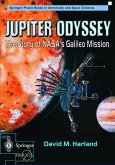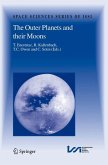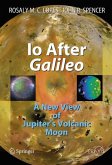Europa - The Ocean Moon tells the story of the Galileo spacecraft probe to Jupiter's moon, Europa. It provides a detailed description of the physical processes, including the dominating tidal forces that operate on Europa, and includes a comprehensive tour of Europa using images taken by Galileo's camera. The book reviews and evaluates the interpretative work carried out to date, providing a philosophical discussion of the scientific process of analyzing results and the pitfalls that accompany it. It also examines the astrobiological constraints on this possible biosphere, and implications for future research, exploration and planetary biological protection. Europa - The Ocean Moon provides a unique understanding of the Galileo images of Europa, discusses the theory of tidal processes that govern its icy ridged and disrupted surface, and examines in detail the physical setting that might sustain extra-terrestrial life in Europa's ocean and icy crust.
From the reviews:
"This book tells the story of the Galileo spacecraft probe to Jupiter's moon, Europa. It provides a detailed description of the physical processes ... . The book reviews and evaluates the interpretative work carried out to date, providing a philosophical discussion of the scientific process of analyzing results and the pitfalls that accompany it. ... provides a unique understanding of the Galileo images of Europa ... ." (Lunar and Planetary Information Bulletin, 2005)
"Greenberg (Univ. of Arizona) offers a very intriguing book that evaluates the scientific evidence for a thin ice crust on the Jovian moon Europa. ... The explanation of Greenberg's theory is clear and concise. Just about any undergraduates, not just geology and astronomy majors, should be able to understand the concepts. ... Summing Up: Highly recommended. General readers; lower-division undergraduates through faculty." (J.R. Kraus, CHOICE, September, 2005)
"Richard Greenberg has written a book that lays out an explanation ... of what the cameras of the Voyager and Galileo missions saw on the surface of Europa. ... The book is beautifully produced and edited by Springer and is well illustrated and indexed. An entire section is given to reference, which greatly increases the value of the book. ... For science and scientific insight I highly recommend the book ... ." (Michael J.S. Belton, Meteoritics & Planetary Science, Vol. 40 (4), 2005)
"Being at the forefront of science is exhilarating on its own. Sharing the wonders with other people increases the satisfaction even more. Richard Greenbergs Europa, The Ocean Moon summarizes his research and that of his colleagues resulting from the Galileo probes mission to Jupiter. Europas ice surface may seem haphazard in construct but with intuition and perception, we can see how science can make reason out of this exotic world." (Mark Mortimer, Universe Today, 15 February 2006)
"I wasdelighted to be invited to review this book. ... In this book, I thought, I would find Greenberg's overview of Europa ... . I was right, but there is an additional dimension that made the book an even more fascinating ... read than I had anticipated. ... is explained with great clarity, and the book can be recommended as a well-illustrated text from which to learn about current interpretations of Europa." (Astronomy & Geophysics, Vol. 46, 2005)
"This book tells the story of the Galileo spacecraft probe to Jupiter's moon, Europa. It provides a detailed description of the physical processes ... . The book reviews and evaluates the interpretative work carried out to date, providing a philosophical discussion of the scientific process of analyzing results and the pitfalls that accompany it. ... provides a unique understanding of the Galileo images of Europa ... ." (Lunar and Planetary Information Bulletin, 2005)
"Greenberg (Univ. of Arizona) offers a very intriguing book that evaluates the scientific evidence for a thin ice crust on the Jovian moon Europa. ... The explanation of Greenberg's theory is clear and concise. Just about any undergraduates, not just geology and astronomy majors, should be able to understand the concepts. ... Summing Up: Highly recommended. General readers; lower-division undergraduates through faculty." (J.R. Kraus, CHOICE, September, 2005)
"Richard Greenberg has written a book that lays out an explanation ... of what the cameras of the Voyager and Galileo missions saw on the surface of Europa. ... The book is beautifully produced and edited by Springer and is well illustrated and indexed. An entire section is given to reference, which greatly increases the value of the book. ... For science and scientific insight I highly recommend the book ... ." (Michael J.S. Belton, Meteoritics & Planetary Science, Vol. 40 (4), 2005)
"Being at the forefront of science is exhilarating on its own. Sharing the wonders with other people increases the satisfaction even more. Richard Greenbergs Europa, The Ocean Moon summarizes his research and that of his colleagues resulting from the Galileo probes mission to Jupiter. Europas ice surface may seem haphazard in construct but with intuition and perception, we can see how science can make reason out of this exotic world." (Mark Mortimer, Universe Today, 15 February 2006)
"I wasdelighted to be invited to review this book. ... In this book, I thought, I would find Greenberg's overview of Europa ... . I was right, but there is an additional dimension that made the book an even more fascinating ... read than I had anticipated. ... is explained with great clarity, and the book can be recommended as a well-illustrated text from which to learn about current interpretations of Europa." (Astronomy & Geophysics, Vol. 46, 2005)
Aus den Rezensionen: "In dem Buch ... wird die Geschichte der Galileo Sonde erzählt, die den Jupitermond Europa untersucht hat. ... Der Autor ... hatte als Mitglied im wissenschaftlichen Team Zugang zu allen wichtigen und relevanten Informationen, die er im vorliegenden Werk verarbeitet hat. Es beinhaltet eine detaillierte Beschreibung der schon erwähnten dominierenden Gezeitenkräfte, die durch eine umfassende bildliche Darstellung von Europa unterstützt wird. ... Das Buch ermöglicht ... einen Einblick in die Forschungsarbeiten, die mit der genauen Untersuchung eines Mondes einhergehen. Es erörtert die Theorie der Gezeitenkräfte ..." (in: Weltraum Facts, 2005, Vol. 12, Issue 4, S. 25)








